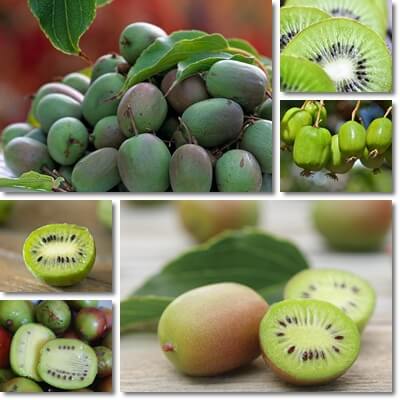Kiwi berries or baby kiwis are a much smaller variety of the fuzzy kiwifruit. Except that kiwi berries are neither fuzzy, nor brown: they have green and even orange, red, brown and purple skin.
You can eat kiwi berries whole, and they taste just like their larger relative: tart and sweet, but juicy and refreshing at the same time. They are an excellent source of dietary fiber and vitamin C for gums and teeth health and anti-inflammatory and immune-boosting properties.
They are also a good source of potassium which is good for high blood pressure, face puffiness and leg swelling. Other notable vitamins and minerals in baby kiwis are vitamins A, E and K, B vitamins and copper, magnesium and manganese.
What is the kiwi berry?
The kiwi berry is a small variety of kiwifruit, the size of a berry. Most common species include: Actinidia arguta, Actinidia kolomikta, Actinidia polygama, Actinidia melanandra, Actinidia purpurea. Not all species are commercially cultivated, although they all produce edible fruit. The variety is also called by other common names such as: the grape or dessert kiwi, the baby kiwi, the arctic or hardy kiwi and the purple or red kiwi.
The kiwi berry is a seasonal fruit, in season from September to October in the Northern hemisphere. The trees are actually climbing vines and are frost-hardy, tolerating temperatures as low as -35 to -40 degrees Celsius (each species has a different tolerance to frost).

What does the kiwi berry look like?
It depends on the species. For the most part, kiwi berries are small, ranging in size from a large strawberry to a grape. They have the distinctive egg shape, but are not brown and fuzzy like the common fuzzy kiwifruit. Instead, they have a smooth, thin, leathery lime green skin – sometimes also red, purple, brown, or simply green blushed with red, brown or purple, depending on the species.
On the inside, the flesh is green with a whitish center and a ring of tiny, reddish-brown or black seeds. The Actinidia polygama species produces fruits that are green when unripe, but bright orange when ripe. Actinidia polygama kiwis have bright orange-colored flesh as well as orange skin when ripe. Other species produce fruits with reddish flesh.
What does the kiwi berry taste like?
Some species produce fruits that are tart-tasting and acidic, while some species produce fruits that are sweeter and less acidic. The flesh is firm and juicy and the skin is thin and smooth, with a leathery texture, but perfectly edible and quite palatable. Overripe kiwi berries have a soft, almost mushy flesh and a mellow, barely acidic taste. You can eat kiwi berries whole: skin, flesh and seeds. The best time to eat baby kiwi is when their skin is slightly shriveled, a sign of ripeness, and blushed with red or darker colored (red, brown or purple, depending on the species). The fruits of some species are even left of the vine until the first frost.
Uses and recipes
Kiwi berries are most commonly eaten raw, although their availability is reduced, both because it’s a seasonal fruit and it spoils quickly, and because few species are commercially cultivated on a larger scale, despite the fruit becoming increasingly popular in recent years. Kiwi berries can be juiced, fermented and made into jam which can be used for pie fillings. They can even be eaten as vegetables, fried and salted, added to salads, paired with rice or meat, added to stews, chutneys or paired with finer cheeses such as Brie or Camembert. For fruit salads, it’s best paired with fruits with low acidity such as bananas, table grapes or nectarines, but also whipped cream.

Kiwi berries nutrition facts per 100 g
- Energetic value: 77 kcal
- Carbohydrates: 18 g
- Sugars: 7.6 g
- Dietary fiber: 3 g
- Fat: 0.6 g
- Protein: 1.2 g
- Vitamin C: 93 mg
- Potassium: 288 mg
Other vitamins and minerals in kiwi berries: B vitamins (B1, B2, B3, B5, B6, B9), vitamins E and K, calcium, copper, iron, magnesium, manganese, phosphorus and zinc. Fruits produced by the Actinidia polygama species are bright orange, indicating a high content of antioxidant carotenoids with pro-vitamin A activity (so good amounts of vitamin A in orange baby kiwi). Kiwi berry varieties with red and purple skin have anthocyanin antioxidants. All baby kiwis are rich in chlorophyll antioxidants, both fruits that are entirely green and fruits that are green with red, purple or brown. Also see the benefits of golden kiwifruit.
Kiwi berries benefits
- Benefits for skin. The high amounts of vitamin C in kiwi berries stimulate the production of collagen which improves skin elasticity and reduces wrinkles appearance for a more youthful skin.
- Good for gums and teeth. With over 100% of the recommended daily intake of vitamin C per 100 g, baby kiwi berries promote gums and teeth health.
- Good for the heart. High in potassium (over 6% of daily requirements) and a source of magnesium (around 5% of daily requirements), but low in sodium (virtually no sodium), kiwi berries are one of the best fruits to eat for high blood pressure.
- Benefits for water retention. Kiwi berries nutrition makes them a good food to eat to combat the side effects of water retention, such as face puffiness, swollen ankles and leg swelling.
- Cholesterol-lowering properties as a result of a good fiber content (3 g of dietary fiber per 100 g of fruit). A tip for getting more fiber into your diet: whenever possible, eat fruits with skin.
- Kiwi berries for diabetes. Kiwi berries have an average glycemic index value of 50 to 55, making them low-glycemic fruits. They can successfully be incorporated into a diabetes diet, provided intake is reasonable.
- Benefits for blood sugar. Kiwi berries are high in carbs (18 g of carbs/100 g) and moderately high in sugar (7.6 g of sugar/100 g), but they are also high in fiber (3 g of fiber/100 g) which allows for a steadier rise in blood sugar levels, provided intake is reasonable.
- Good food to eat for healthy weight loss. Kiwi berries have around 77 calories per 100 g, but lots of fiber and good nutrition, making them a good food to consider for healthy weight loss.
- Benefits for pregnant women. Kiwi berries have benefits for both men and women, but are especially good for pregnant women because of their nutritional value, notably excellent vitamin C content and good content of dietary fiber to combat constipation, B vitamins for normal baby development and potassium and magnesium to helps lower high blood pressure during pregnancy.
- Immune system-boosting and antimicrobial properties from vitamin C, making them an ideal fruit to eat during cold and flu season.
- Rich in antioxidants: vitamin A, copper, manganese, vitamin E, carotenoid antioxidants with vitamin A activity (in orange kiwis) and anthocyanins in red and purple kiwis.
- Good for blood coagulation: all varieties except completely orange baby kiwis are good sources of vitamin K for blood coagulation.
